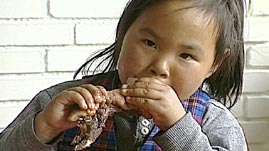Teachers' Domain - Digital Media for the Classroom and Professional Development
User: Preview

Source: LOKE Films and AMAP 2002 Assessment



This video segment adapted from LOKE Films and the Arctic Monitoring and Assessment Programme describes how people in the Arctic are exposed to high levels of toxic contaminants such as mercury and PCBs. Learn how persistent organic pollutants travel through the food chain and pose serious health risks to humans who consume contaminated animals. Examine how different populations are affected, and how people who eat traditional foods high on the marine food chain (such as polar bear, seal, and some types of whale) are most at risk.
The animals and people who live in the cold Arctic environment rely on fat in their bodies for both insulation and for energy. Unfortunately, toxic chemicals known as persistent organic pollutants (POPs) are lipophilic, meaning that they have an affinity for fat and accumulate in fatty tissues and organs. In addition, organisms in the Arctic are particularly vulnerable to pollutants because atmospheric circulation and ocean currents carry pollution from lower latitudes to the Arctic, where the cold conditions trap the contaminants and prevent further migration.
Pollutants, such as polychlorinated biphenyls (PCBs) and mercury, are released into the environment through various industrial and agricultural processes. In the environment, mercury can convert to methylmercury—an organic form of mercury that is particularly toxic and easily absorbed by organisms. These pollutants enter into ecosystems at the bottom of the food chain when organisms absorb them from the air and water. In species at low trophic levels on the food chain, the concentrations of contaminants are not much higher than those found in the air and water. However, once the contaminants enter the food chain, they can reach toxic levels through the process of biomagnification. When a predator consumes its prey, it takes in all the toxins in the organism as well as the food energy; the more contaminated organisms it eats, the more toxins it acquires and stores in its fatty tissues. Thus, at each successive trophic level, the contaminant burden increases.
People who consume the fat and meat of contaminated animals are at risk from exposure to high concentrations of toxins; POPs can affect reproductive, neurologic, and immunologic health. However, different populations of people in the Arctic have different diets and therefore have varying health risks. For example, whale is a common traditional subsistence food source; however, some types of whale are more toxic than others. The Iñupiat in northern Alaska hunt bowhead whales. These are baleen whales that primarily eat krill and shrimp, which are organisms low on the food chain. Thus bowhead whales accumulate low levels of contaminants and do not pose much risk to the people who eat them. On the other hand, people in the Faroe Islands are at greater risk because they eat pilot whales, which are higher on the food chain (they eat squid and fish). The people in the northern and eastern regions of Greenland are also exposed to high levels of toxins; as part of their traditional diet, they eat polar bear, which is at the top of the Arctic food web, and, as a result, has the highest level of contaminants of any Arctic species.
With respect to POPs, eating animals from lower trophic levels will reduce the health risks. However, proximity to source regions of pollutants also affects contamination levels. For example, there are higher concentrations of POPs in the western North American Arctic, near industrialized Asia, compared to farther east. Thus, public health advisories must be made regionally. Such advisories consider pollution levels as well as weigh the risks and benefits of altering the traditional diet, which—in addition to providing important nutrients—is part of a cultural identity.
 Loading Standards
Loading Standards Teachers' Domain is proud to be a Pathways portal to the National Science Digital Library.
Teachers' Domain is proud to be a Pathways portal to the National Science Digital Library.
